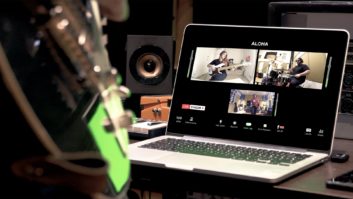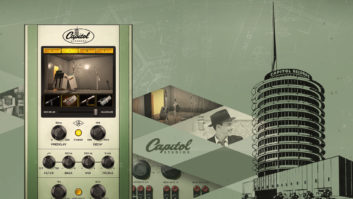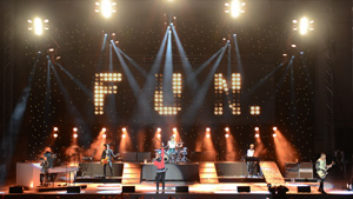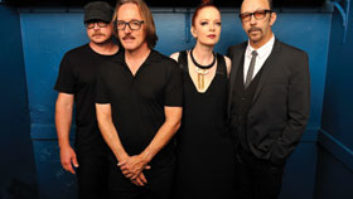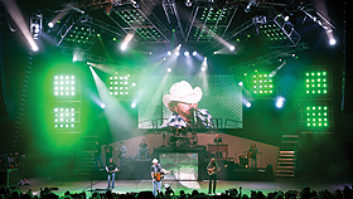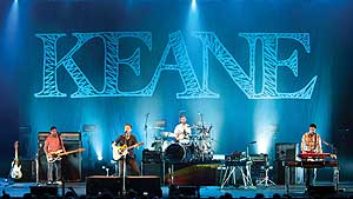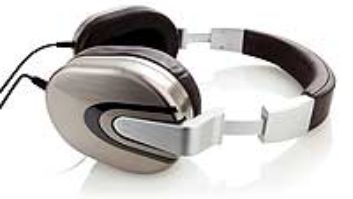With a recent nomination for Best Rock Group at the Brit Awards (the UK’s version of the Grammys) and a sold-out international tour for their latest release, Absolution, UK trio Muse (Matt Bellamy, lead vocals/guitar/keyboards; Dominic Howard, drums; and Chris Wolstenholme, bass/backing vocals) finally wound their way through the U.S., hitting arenas and larger-sized theaters. Mix caught up with the Britpoppers in early April at San Francisco’s Bill Graham Civic Auditorium.
Guitar/keyboard programmer tech Des Broadbery (right) is responsible for maintaining and operating Bellamy’s onstage guitar and keyboard systems; he also works the backup switching of effects and amps. “I also have Novation Remote Zero that enables me to control Matthew’s piano onstage, recalling presets and so on,” he adds, “and a Yamaha 01V to monitor both guitar and keys.”
Matt Bellamy’s axes include custom-made Hugh Mansons: seven electric and two seven-string pick-up acoustics. Guitar tech Paul Spencer (left) maintains all of these guitars, including tuning and backup switching of effects and amps. As for amps, Bellamy’s arsenal includes two Diezel VH 4 heads (one onstage), Marshall 1959HW 100-watt head and a Vox AC30 head; speakers comprise two 4×12 onstage and two Marshall 4×12 offstage miked for FOH, as well as a Skrydstrup AS 4 amp switcher.
In addition, the tour is carrying two guitar effects rigs; highlights include a Shure UR 4D four-way wireless system, Skrydstrup four-way amp-switching unit, Kenton wireless MIDI receiver, Avalon VT 737SP preamp/compressor for vocals, Muse Research Receptor, ETA Systems PD11 Power Conditioner, TC Electronic TC 2290 Dynamic Digital Delay and Nord Modular G2 synth.
Bassist Chris Wolstenholme uses Fender Jazz basses and a Rickenbacker. The system is based around the Sound Sculpture Switchblade GL rackmount switching system and Rocktron All Access pedal, which allows the bassist to change several pedals with one switch. Bass tech Shane Goodwin (below, left) explains that this is extremely helpful as the band will go “from the heaviest riffs down to a piano interlude. Without this setup, Chris or myself would have to be a good dancer to turn off all the pedals at the same time. To this day, I have not seen and or heard anyone play like he does.
“Chris uses four Marshall DBS bass heads, which are not made anymore; we own eight,” he continues. “With the show being as hectic as it is, I have been fortunate to help Chris and Matt by doing most of their pedal changing, which has freed them to be able to put on an amazing rock show and not be tied down to a pedal board.”
Front-of-house engineer Marc Carolan (who also works as a producer/engineer in his Dublin-based Suite Studios) first used a Digidesign board while mixing for The Cure. “It was a natural progression to use it on Muse’s global tour,” Carolan explains. “Even with the Digidesign Show console, there are still things I love to have by nature of the specific sound they give me, such as Midas XL42 preamps for that classic Midas sound.” Alongside his digital board, Carolan is carrying racks of Empirical Labs Distressors and BSS Audio 901 multiband compressors for vocals; dbx 160s on kick and snare; Tube-Tech LCA-2B on bass and guitars; Eventide H3000 for vocal processing; and Yamaha SPX2000s for drum effects.
For the West Coast leg of the tour, Rat Sound is providing P.A. with Kevin McKenzie acting as system engineer. The main system comprises L-Acoustics V-DOSC, 12 per side; dV-DOSC, three per side; Rat subs, 12 per side; and V-DOSC (six per side) and dV-DOSC (three per side) for sidefills.
“I use Neumann KSM 104s on vocals due to Matt’s ‘extreme’ mic technique,” Carolan says. “I also use a single mic on guitars: a Royer V122 on the cab with an SE Electronics Reflexion filter. My mixing approach for this band is to truly reflect what they are performing. Sometimes that may be a very ‘live’ or stripped-back approach; sometimes it is a much denser and layered approach, especially in some of the newer material. Muse is always a very inspiring band to mix. They give you so much to work with.”
Drummer Dominic Howard’s kit is miked with a Beyer M88 and Shure 91 (kick), Shure SM57 and Neumann KMS 105 (snare), AKG C 451 (hi-hat/ride), Shure Beta 98 (toms) and AKG C 414 (overheads). “For ‘Supermassive Black Hole,’” drum tech Stuart Quinnell (right) adds, “we are using a Roland TMC-6 trigger to MIDI converter on the snare and kick drum to a Roland SPD-S.”
Monitor engineer Adam Taylor is also manning a Digidesign D-Show console; he first used one this past April and mastered it quickly and easily. “I find the console well-laid-out and easy to use in its configuration as a monitor console using fader flip,” he says. “The plug-in feature is a valuable tool for me, although not the sole reason why I’m using the console. The extensive automation possibilities are also a great help in doing what I need to do for the band.”
Unlike Carolan, Taylor is not carrying much in the way of outboard gear, relying mostly on onboard inserts except for three dbx 160A comps used on male vocals. “Matt and Chris are both using Neumann KMS 104s for vocal mics,” Taylor adds, “and for their in-ear monitors, we’re using Shure PSM 700 systems.”
WATCH: Muse Through Pictures
